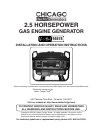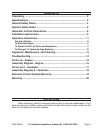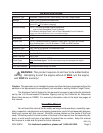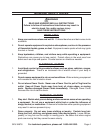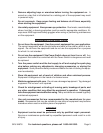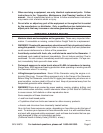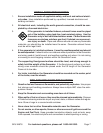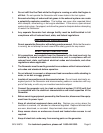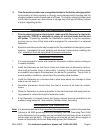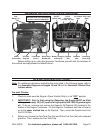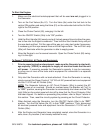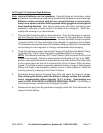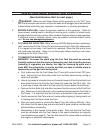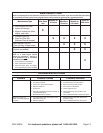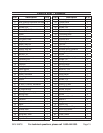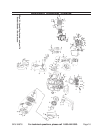
Page 9SKU 94678
For technical questions, please call 1-800-444-3353.
INSTALLATION INSTRUCTIONS
Prior to powering tools and equipment, make sure the Generator’s rated watt-
age capacity (1000 W) is adequate to supply all electrical loads that the unit
will power. If powering exceeds the Generator’s capacity, it may be necessary
to group one or more of the tools and/or equipment for connection to a separate
Generator.
Electrical and other permits may be required for the installation of emergency power
systems. Investigate the local building and electrical codes before installing this
unit. Installation must be completed by licensed contractors.
GENERAL LOCATION
It is recommended to locate and install the Generator outdoors where cooling air
is readily available.
Install the Generator so that the air inlets and outlets are not blocked by obstruc-
tions such as bushes, trees, or snow drifts. Locating it in the path of heavy winds
or snowdrifts may require the placement of a barrier for protection. The air inlet, in
normal weather conditions, should face the prevailing wind direction.
Install the Generator on a concrete slab or other area where rain drainage or flood
waters can not reach it.
Generator placement should allow four feet of access to all sides for mainte-
nance.
Place the Generator as close as possible to the electrical tools and equipment be-
ing powered to reduce the length of extension cords.
If the Generator in located indoors the Engine exhaust must be ventilated to the
outdoors using leakproof, heat resistant, flexible, metal, flex tubing.
GROUNDING THE GENERATOR
Note: It is recommended that only a trained and licensed electrician perform this procedure.
Connect a #6 AWG grounding wire (not included) from the Grounding Point (55a)
on the Generator to a grounding rod (not included) that has been driven at least 24
inches deep into the earth. The grounding rod must be an earth-driven copper or
brass rod (electrode) which can adequately ground the Generator.
1.
2.
1.
2.
3.
4.
5.
6.
This Generator provides raw, unregulated output to the battery charging outlet.
Incorporating an inline regulator is strongly recommended while charging and the
charging process must be monitored at all times. The battery charging output must
not be used to power any other device or charge any other type of battery without
a proper regulating device.
10.



